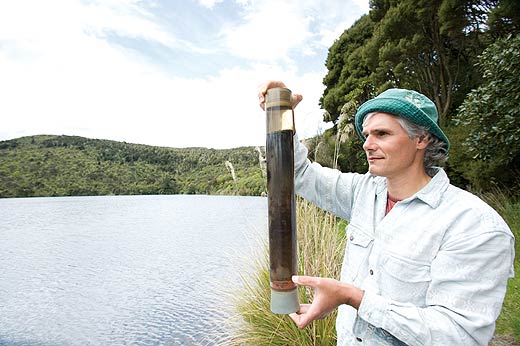

Dr Marc Schallenberg:
“Working on environmental issues that challenge many peoples' lifestyle and socio-economic values means that, sometimes, I also need to be an advocate for our natural heritage...”
The pristine snow that crowns the Southern Alps is like white gold to Wanaka, attracting thousands to the resort and the skifields.
But now there's a different, less welcome kind of snow – one that has stirred up a mystery for lake expert Dr Marc Schallenberg (Department of Zoology).
“Lake snow” is an unusual algal growth that looks like floating snowflakes. Wanaka fishermen noticed it catching on their lines about seven years ago and now it's being blamed for clogged water filters, showerheads and washing machines.
After a severe outbreak in 2007, the Wanaka community approached the University for answers, and Schallenberg and the University's Ecology Research Group began investigating.* “This kind of growth is reported extensively in marine environments, but rarely in lakes,” says Schallenberg. “I'd never seen it before in the hundred or so lakes I've worked, but 'lake snow' has been reported from some overseas lakes.
“It's formed by microscopic algae which, for some reason, secrete large amounts of sticky polysaccharides which cause the algae and other microscopic organisms to clump together to make visible 'flakes'. But why the algae do this and what effects it has on the lake ecosystem and fishery are still unknown.”
Possible triggers for the bloom could be changing land use and increased nutrients in the lake, but the jury is out while research continues, he says.
New Zealand, with 3,500 lakes, faces many freshwater issues, yet has relatively few qualified people to help solve them.
A combination of economic pressures and inadequate environmental management is leading to the rapid deterioration of many of New Zealand's fresh waters, says Schallenberg.
“Being a scientist, the tendency is simply to inform society and leave it to them to decide whether or not to manage things.
“However, working on environmental issues that challenge many people's lifestyle and socio-economic values mean that, sometimes, I also need to be an advocate for our natural heritage and for future generations of Kiwis who might want to experience it.
“I find it very rewarding to engage with locals and community groups because they often know things about their lakes that might take scientists from the city years of careful observation to discover.
“And, because we're working on their lakes, local communities often deeply appreciate what we are doing.”
Schallenberg is also working with community groups interested in managing and restoring Lakes Waihola and Waipori, Lake Hayes, Hawkesbury Lagoon, and Waituna Lagoon in Southland, and has recently been appointed by the Minister of Conservation to be one of The Guardians of Lakes Monowai, Manapouri and Te Anau.
Funding
- Foundation for Research, Science and Technology
- NIWA
- University of Otago
- Otago Regional Council